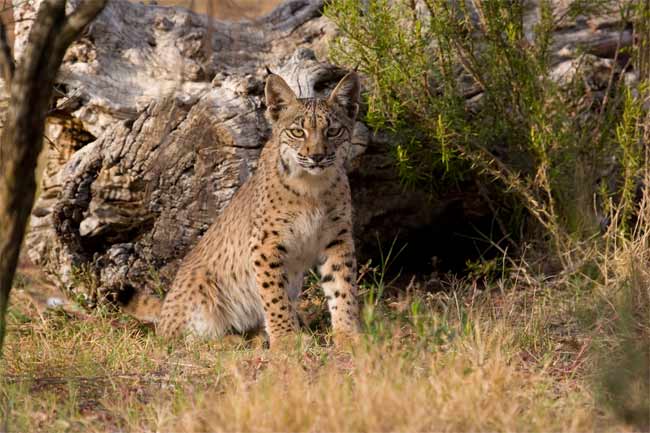Facts About Bobcats & Other Lynx

Lynx are cats that are related to tigers, lions, domestic cats, jaguars and other members of the Felidae family, according to the Integrated Taxonomic Information System (ITIS). There are four species of lynx, including the bobcat. What distinguishes these cats from their relatives are their compact legs, stubby tail and erect ears topped with pointed, black tufts of fur.
Size
Lynx are small cats when compared with tigers and lions. From their head to their rump, they are about 32 to 40 inches (80 to 100 centimeters) long. Their tails add another 4 to 8 inches (10 to 20 cm) to their length, on average. Lynx weigh as much as a small child — about 22 to 44 lbs. (10 to 20 kilograms).
Lynx species that live in Asia and Europe are larger than the species living in North America. The largest lynx is the Eurasian lynx, according to Big Cat Rescue. It is 31 to 43 inches (80 to 110 cm) long and weighs 33 to 64 lbs. (15 to 29 kg). The shortest lynx is the bobcat, which is 26 to 41 inches (65 to 105 cm) long. The lightest lynx is the Canadian lynx, which weighs 11 to 37 lbs. (5 to 17 kg).
Habitat
These cats live in the cooler areas of northern Europe, North America and Asia. Most lynx are built for the cold, with thick fur coats and special paws. When it takes a step, the lynx's paws spread out, making it easier for it to walk on snow. It is like having built-in snowshoes. These paws are also covered in thick fur for added protection.
The bobcat differs from other lynx. They have smaller feet and don't have furry soles. Bobcats generally don't live in areas with a lot of snow, according to the San Diego Zoo. They live in a variety of areas, including forests, swamps and deserts. They also like rocky areas that provide hiding places.
Lynx like to roam alone and are very territorial. Sometimes, after leaving their mother, siblings will stick together for a while. They eventually go their separate ways, though.
Lynx hunt at night and sleep during the day. They make their beds in caves, rock crevices and brush.
Get the world’s most fascinating discoveries delivered straight to your inbox.
Diet
Lynx, like other cats, are carnivores, which means they only eat meat. They leap at their prey and kill it with a bite to the neck or head.
The Canadian lynx relies on the snowshoe hare as its main source of food. When there are fewer snowshoe hares, the Canadian lynx's population will also decrease, according to the San Diego Zoo. They will also eat squirrels, mice and birds.
The Eurasian lynx is bigger than the Canadian lynx and will prey on large game, such as deer. They also eat smaller animals, such as rodents and birds.
Offspring
A male lynx becomes mature at about 2.5 years old. Females mature a little bit more quickly and are ready to mate at 2 years old. Lynxes mate in early spring or late winter. The female is pregnant for 62 to 73 days before she gives birth. A group of baby lynx is called a litter; individual cats in the litter are called kittens. A litter usually consists of one to eight kittens. Newborn kittens weigh 6 to 14 ounces (175 to 400 g).
The kittens nurse for four to five months. At 10 months, they become independent, but they don't leave their mothers until they are 1 year old.
Classification/taxonomy
The taxonomy of lynx, according to ITIS, is:
- Kingdom: Animalia
- Phylum: Chordata
- Class: Mammalia
- Order: Carnivora
- Family: Felidae
- Subfamily: Felinae
- Genus: Lynx
- Species: Lynx canadensis (Canada lynx or Canadian lynx), Lynx lynx (Eurasian lynx), Lynx pardinus (Spanish lynx or Iberian lynx) and Lynx rufus (bobcat)
Conservation status
The Iberian lynx is categorized as critically endangered on the International Union for Conservation of Nature's Red List. It is believed that there are only 143 of these animals left in the wild. Climate change is a huge threat. Drier climates caused by global warming may kill the cat's food source, according to a study in the journal Natural Climate Change.
Other lynx species are considered to have stable populations and are not endangered, according to the IUCN.
Other facts
Lynx have amazing hearing and sight. The long hairs on their ears help lynx hear prey more clearly. A lynx's eyes are so keen that they can spot a mouse 250 feet (75 meters) away, according to National Geographic.
It is believed that the lynx's name may have come from Greek word leukos, which means bright. This may have been a reference to how the lynx's eyes shine when light hits them, according to the San Diego Zoo.
These big cats purr, just like house cats. A mother will often purr while taking care of her kittens.
Nina Sen contributed to this article.
Other resources


